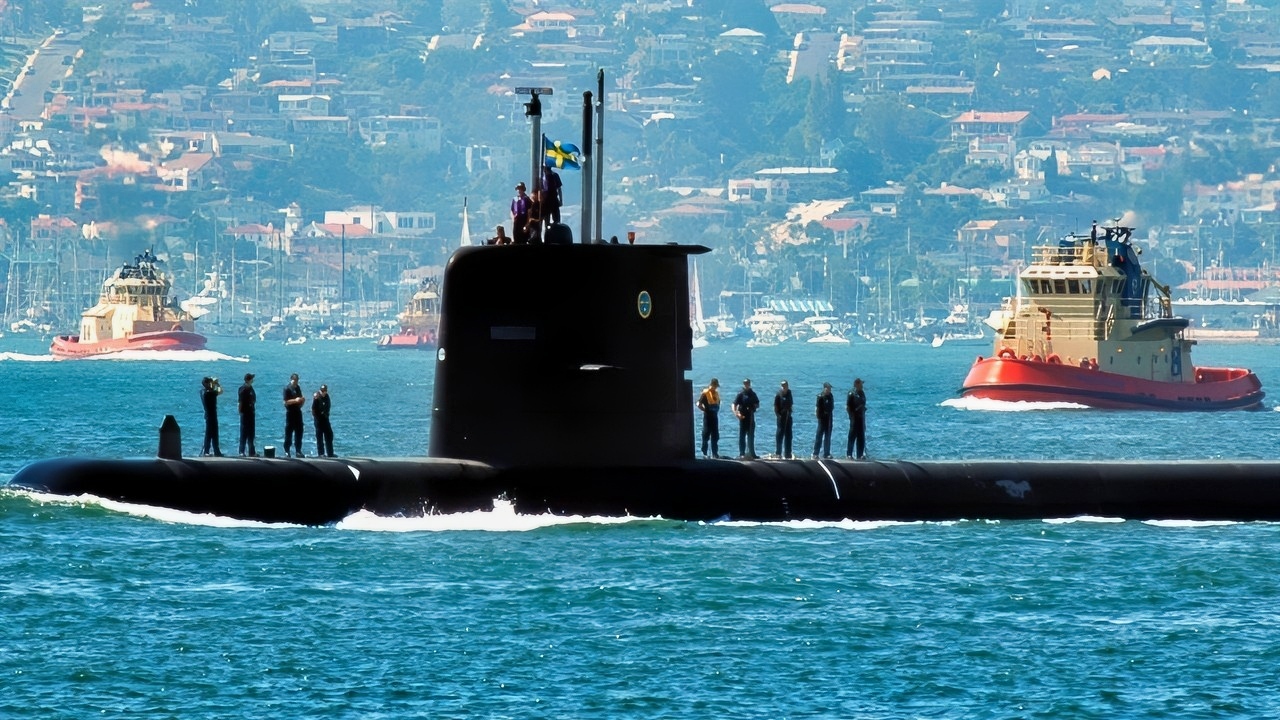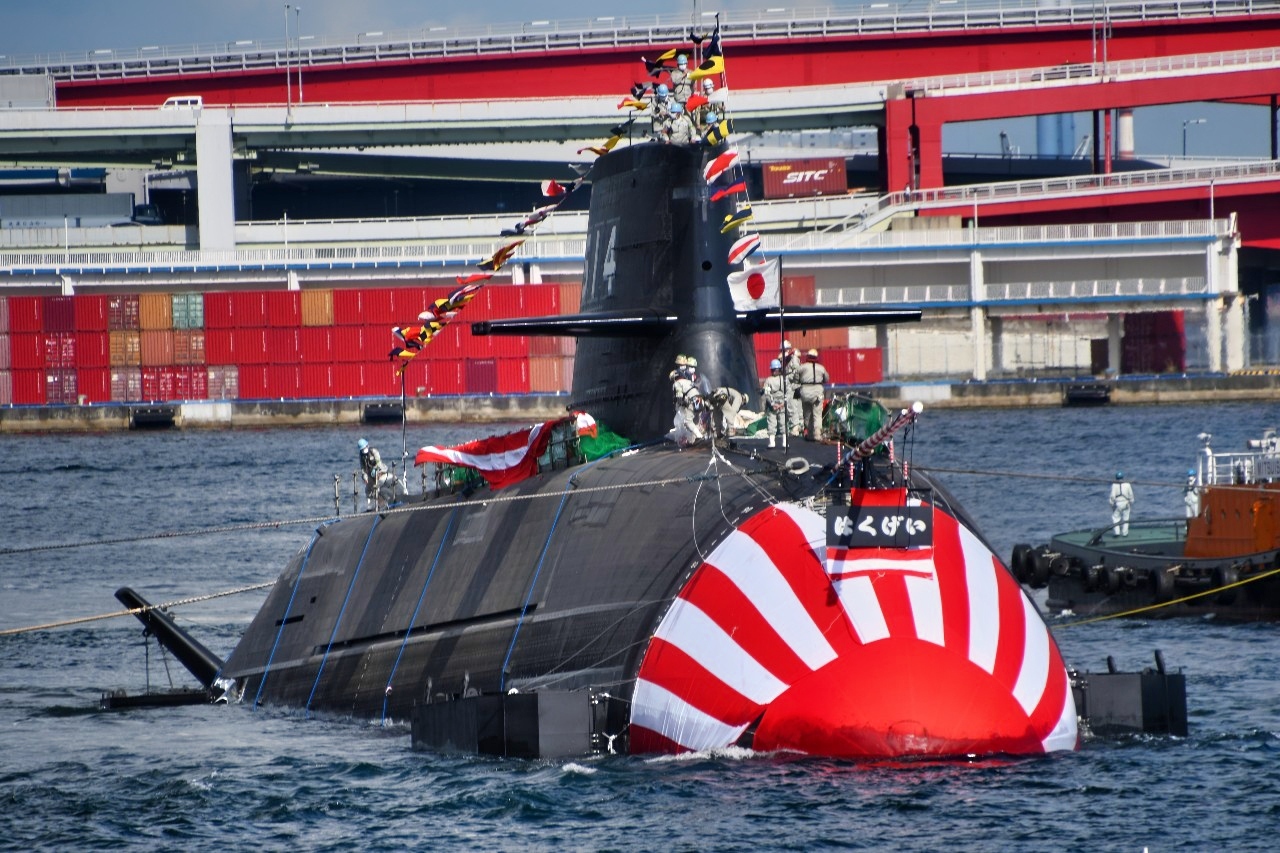Key Points and Summary: The U.S. Navy Can’t Miss the AIP Submarine Advantage
-Air-independent propulsion (AIP) submarines are reshaping undersea warfare. Sweden, Japan, and South Korea have built highly capable conventional boats that can stay submerged for weeks, operate quietly in cluttered littorals, and even deliver land-attack strikes.

(Oct. 1, 2005) – The Swedish diesel-powered attack submarine HMS Gotland transits through San Diego Harbor during the “Sea and Air Parade” held as part of Fleet Week San Diego 2005. Fleet Week San Diego is a three-week tribute to Southern California-area military members and their families. U.S. Navy photo by Photographer’s Mate 2nd Class Patricia R. Totemeier (RELEASED)
-Their designs are tuned to geography and strategy, not budget constraints, and show that “non-nuclear” does not mean second rate.
-By contrast, the U.S. Navy’s all-nuclear attack sub force is shrinking under industrial strain and rising costs.
-The article argues that Washington should add an AIP-based tier to its fleet—co-designed with allies—to restore numbers, expand options, and create a more flexible, layered undersea deterrent.
The AIP Revolution Has Arrived
Air-independent propulsion (AIP) submarines are transforming how small and mid-tier powers project force, deter aggression, and defend maritime approaches
Japan, Sweden, and South Korea have shown that advanced conventional boats can deliver many of the effects once reserved for nuclear fleets. Meanwhile, the U.S. Navy — the world’s most capable but increasingly overstretched submarine force — is struggling to build enough boats to meet its strategic needs.
The conclusion is unavoidable: the Navy needs more hulls in the water, and AIP technology offers a credible, near-term way to expand the fleet’s mass, reach, and flexibility.
Why AIP Matters
AIP systems blur the old binary between diesel-electric and nuclear propulsion. These submarines can remain submerged for extended periods, moving slowly, silently, and cheaply. Sweden’s Gotland class demonstrated how Stirling-engine AIP could loiter for weeks in the Baltic’s shallow, acoustically complex waters.
The next-generation A26 Blekinge class pushes the concept further — purpose-built for intelligence gathering, seabed warfare, and special operations, optimized not for speed but for stealth, persistence, and precision.
Japan took the concept and tailored it to the Pacific. Its Sōryū and Taigei classes began with Swedish AIPs and then transitioned to cutting-edge lithium-ion batteries, producing conventional submarines with remarkable endurance and low acoustic signatures. Designed to patrol vast ocean spaces, slip through chokepoints, and shadow adversary fleets, they are ideal for the crowded and contested littorals of the Western Pacific. When geography demands stealth and reach rather than sprint speed, Japan’s boats offer both.
South Korea’s KSS-III represents an even more ambitious leap. Equipped with fuel-cell AIP, large vertical launch tubes, and long-endurance patrol capability, these submarines merge AIP efficiency with near-nuclear striking power. They can remain submerged for roughly twenty days, conduct land-attack missions, and carry a suite of cruise missiles capable of holding regional targets at risk.
In effect, Seoul has built a conventional submarine with a strategic punch — a survivable and scalable deterrent suited to both the North Korean threat and the broader balance in Northeast Asia.
Japan, Sweden, and South Korea: Case Studies in Strategic Fit
Each nation has built AIP capabilities suited to its strategic environment. Sweden needs stealth in the Baltic. Japan needs endurance across a vast archipelagic frontier. South Korea needs deterrent firepower and survivability. The common thread is clear: these are not “poor man’s submarines.”
They are instruments of national strategy, purpose-built for the missions their regions demand.
For the U.S. Navy, this revolution should be a wake-up call. America’s attack submarine fleet — anchored by the Virginia and aging Los Angeles classes — remains world-class, but the numbers are worrying. Shipyard delays, workforce shortages, and rising costs mean the Navy cannot build nuclear submarines fast enough.
The fleet is projected to shrink before it grows again, even as demands intensify across the Atlantic, Pacific, and Arctic. Nuclear submarines are extraordinary platforms, but they are expensive and time-consuming to build.
Why the U.S. Navy Should Take Notice
AIP submarines offer a way to restore mass and operational elasticity. In shallow or confined waters, modern AIP boats can be quieter than nuclear submarines, whose cooling systems generate detectable noise at low speeds.
They are cheaper, faster to build, and ideal for missions that do not require nuclear speed: chokepoint surveillance, regional denial, littorals dominance, and seabed warfare. The United States does not need nuclear propulsion everywhere — it needs stealth, persistence, and numbers where adversaries operate closest to home.
Resistance to conventional submarines in the U.S. Navy is largely cultural. For decades, nuclear propulsion has been synonymous with American undersea power. But Japan, Sweden, and South Korea have shown that conventional does not mean inferior — it means adaptable. The U.S. does not need to abandon nuclear excellence. It needs to complement it.
Addressing the Objections
Critics say AIP submarines lack global range and high-speed transit. True, but irrelevant. No one proposes replacing SSNs with AIP boats. A layered fleet — nuclear for blue-water dominance, AIP for contested near-seas — would give the Navy a more distributed and resilient undersea posture. Another objection concerns basing and logistics. Yet the U.S. alliance network already includes forward facilities in Japan, Guam, Australia, and possibly the Philippines. These hubs could easily sustain rotational AIP deployments.
Cost is the most decisive factor. A single Virginia-class SSN costs around $3 billion and takes nearly a decade to complete. A modern AIP boat costs a fraction of that and can be delivered in half the time. When deterrence depends on both quality and quantity, the economists argue for diversification.
Implementation in the U.S. Context
Implementation is straightforward.
The Navy should deploy a class of AIP or battery-augmented diesel submarines co-designed with allies. Collaboration with Japan, Sweden, and South Korea would speed development and ensure interoperability. U.S. shipyards — especially smaller yards excluded from nuclear work — could handle construction.
That would not only expand the fleet but strengthen the industrial base essential to American maritime power. Procurement should emphasize proven technology and modular design, producing submarines suited for operations in the Indo-Pacific, Arctic, and Atlantic littorals.
Broader Strategic Implications
The broader implications reach far beyond acquisition. Embracing AIP submarines would signal a shift in naval thinking — from platform maximalism to strategic adaptability. It would reinforce alliances, deepen co-production partnerships, and strengthen deterrence in regions where the U.S. must compete without assuming unlimited resources.
It fits a broader strategic logic: defend the near seas, empower allies, and avoid the illusion of global omnipresence.
A larger, more flexible undersea force would complicate adversary planning and ease the burden on overstretched SSNs. Numbers matter in submarine warfare, and more hulls — even if conventional — give the U.S. options it currently lacks. In the undersea domain, uncertainty is the highest form of deterrence.
The U.S. Navy Should Embrace AIP Submarines
The strategic tide is already turning. AIP-equipped submarines are no longer curiosities in the Baltic or Sea of Japan; they are shaping the future of undersea competition. Japan, Sweden, and South Korea have embraced the revolution.

Taigei-Class Submarine from Japan. Image Credit: Creative Commons.

Taigei-Class Submarine from Japan. Image Credit: Creative Commons.
The United States cannot afford to ignore it. A mixed fleet — SSNs for global reach, AIP boats for regional dominance, allied cooperation for depth — would offer a more balanced, sustainable posture for the century ahead.
The oceans will belong not to the biggest fleets, but to the most adaptable. The revolution is here, and those who fail to respond will find themselves outpaced beneath the waves.
About the Author: Dr. Andrew Latham
Andrew Latham is a non-resident fellow at Defense Priorities and a professor of international relations and political theory at Macalester College in Saint Paul, MN. You can follow him on X: @aakatham. He writes a daily column for the National Security Journal.
More Military
Could America Have Lost the Revolutionary War?
The Marines Don’t Have Tanks Anymore
The Essex-Class Aircraft Carriers Have An Embarrassing Message for the U.S. Navy
‘New’ Mach 4 MiG-41 6th Generation Stealth Fighter Has Warning for U.S. Air Force
Boeing’s F-47 NGAD 6th Generation Stealth Fighter Is No ‘Mission Impossible’










